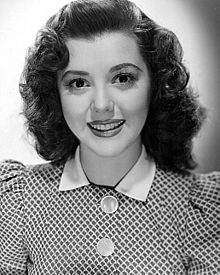ROSIE THE RIVETER (1944)
Why you should watch it: Republic Pictures didn’t turn out a lot of musicals, but the ones the studio produced usually had something extra special. Here they hired one of the best female singers during the war years, Jane Frazee. The script is well written– a hilarious romantic comedy set-up with Jane and her girlfriend Vera Vague sharing a room in a boarding house with two single men. The way the writers get around the production code is quite clever!

More reasons: Vera’s deadpan deliveries are wonderful; there’s a lot of witty dialogue from beginning to end; and a marvelous supporting cast that includes Maude Eburne and Carl (Alfalfa) Switzer as a teenager. Plus, there’s a fun scene where the gals have no clothes on and are locked out of the boarding house in the rain. Naturally, they get picked up by the police (you have to see it!). And don’t miss the rousing finale filmed at an aviation factory. There’s a restored print at the Paramount Vault page on YouTube.
*****
MR. MUSIC (1950)
Why you should watch it: Every so often a charming musical comes along that starts slow and builds into something wonderful. This is just such a picture. When Paramount released it in 1950, Bing Crosby was at the peak of his stardom, and his ability as a vocalist is very much in evidence. Plus it helps that he has been paired with Nancy Olson who always makes a fine leading lady.

More reasons: The rest of the cast is quite dandy. There’s Charles Coburn in a supporting role, and Robert Stack, too. Character actress Ida Moore, who plays Aunt Amy, is so cute she nearly walks off with the entire show. And don’t forget appearances by Dorothy Kirsten, Peggy Lee and Groucho Marx. It’s a winner all around. According to Variety, this film was one of the top box office hits the year it was released.
*****
RICH, YOUNG AND PRETTY (1951)
Why you should watch it: The arrangements in this MGM Technicolor musical are nicely done. Plus the pairing of studio songbird Jane Powell with young Vic Damone is inspired, since their voices work together so well.

More reasons: On a serious note, the film has a point to make about xenophobia (the fear of foreign cultures). The father, played by Wendell Corey, believes his marriage to the mother, Danielle Darrieux, was a mistake. As a result, he has transferred his feelings on to their daughter (Powell), not to marry outside one’s own culture. So she is persuaded to break things off with Damone’s character, until at the end she discovers Darrieux is her mother and that she is half-French. It’s a cathartic moment for her.





































